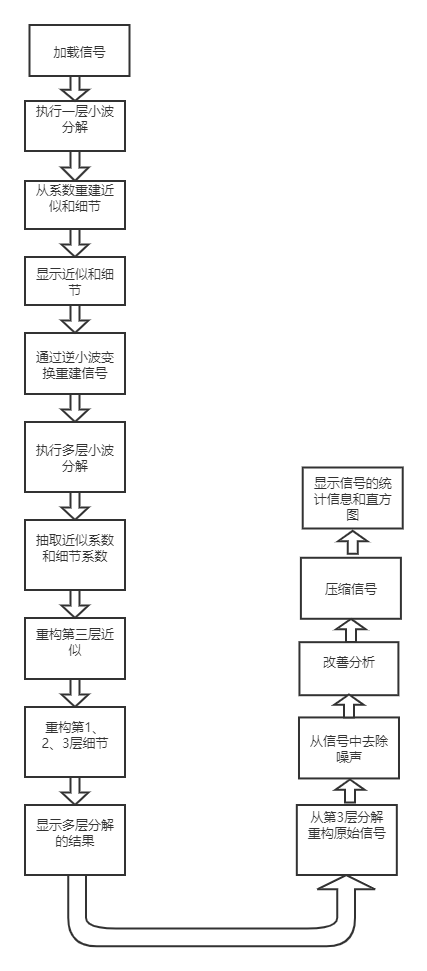

对信号进行一层分解
clc;
clear;
% 获取噪声信号
load('matlab.mat');
sig = M(1,1:1400);
SignalLength = length(sig);
%使用db1分解1层
[cA1,cD1] = dwt(sig,'db1');
%从系数 cA1 和 cD1 中构建一层近似A1 和细节 D1
A1 = upcoef('a',cA1,'db1',1,SignalLength);
D1 = upcoef('d',cD1,'db1',1,SignalLength);
% %或
% A1 = idwt(cA1,[],'db1',l_s);
% D1 = idwt([],cD1,'db1',l_s);
%显示近似和细节
subplot(1,2,1); plot(A1); title('Approximation A1')
subplot(1,2,2); plot(D1); title('Detail D1')
%使用逆小波变换恢复信号
A0 = idwt(cA1,cD1,'db1',SignalLength);
err = max(abs(sig-A0))
对信号进行三层分解
[C,L] = wavedec(sig,3,'db1');%函数返回 3 层分解的各组分系数C(连接在一个向量里) ,向量 L 里返回的是各组分的长度。
%抽取近似系数和细节系数
%从 C 中抽取 3 层近似系数
cA3 = appcoef(C,L,'db1',3);
%从 C 中抽取 3、2、1 层细节系数
[cD1,cD2,cD3] = detcoef(C,L,[1,2,3]);
%或者
%cD3 = detcoef(C,L,3);
%cD2 = detcoef(C,L,2);
%cD1 = detcoef(C,L,1);
%重建 3 层近似和 1、2、3 层细节
%从 C 中重建 3 层近似
A3 = wrcoef('a',C,L,'db1',3);
%从 C 中重建 1、2、3 层细节
D1 = wrcoef('d',C,L,'db1',1);
D2 = wrcoef('d',C,L,'db1',2);
D3 = wrcoef('d',C,L,'db1',3);
%显示多层分解的结果
%显示 3 层分解的结果
figure(2)
subplot(2,2,1); plot(A3);
title('Approximation A3')
subplot(2,2,2); plot(D1);
title('Detail D1')
subplot(2,2,3); plot(D2);
title('Detail D2')
subplot(2,2,4); plot(D3);
title('Detail D3')
%从 3 层分解中重建原始信号
A0 = waverec(C,L,'db1');
err = max(abs(sig-A0))
% 我们注意到连续的近似随着越来越多的高频信息从信号中滤除,
% 噪声变得越
% 来越少。 3 层近似与原始信号对比会发现变得很干净。对比近似和原始信号,如下
figure(3)
subplot(2,1,1);plot(sig);title('Original'); axis off
subplot(2,1,2);plot(A3);title('Level 3 Approximation');axis off
这篇博客是参考百度文档上一位大佬写的,这是数据和文章的链接
链接:https://pan.baidu.com/s/19_jazLnyBuperh7ME5NG8Q
提取码:aonu